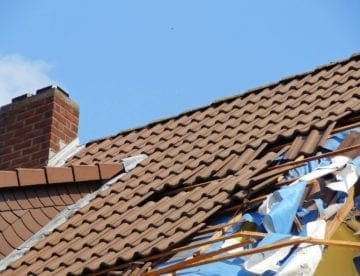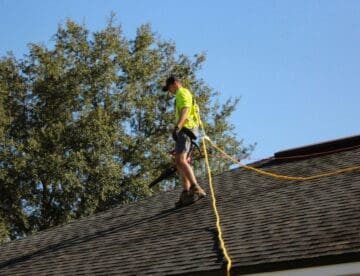Do you want to save money on your energy bills? Are you interested in making your home more environmentally friendly? Installing energy-efficient roofing can significantly impact your energy consumption, carbon footprint, and overall sustainability.
Florida’s warm and humid climate makes energy-efficient roofing the best option. Cool roofs, metal roofs, and solar panels help to reflect sunlight and minimize heat absorption. These roofing solutions help increase energy efficiency, reducing the need for cooling in sizzling temperatures. Also, durable, energy-efficient roofing enhances the resilience of roofs against extreme weather events.
You probably have many questions if you are considering energy-efficient roofing in Florida. Here are a few common questions residents of the Sunshine State ask:
- Is an energy-efficient roofing system easy to install?
- What are the costs involved to make my roof energy efficient?
- How much can I save on energy costs by installing a cool roof coating?
- What are common maintenance issues of an energy-efficient roofing system?
This article addresses the top FAQs on energy-efficient roofing options. Here, you will get the information you need to make an informed decision for your home.
Exploring Types of Energy-Efficient Roofing
There are several types of energy-efficient roofing materials for homes in Florida. These range from solar tiles to metal roofing, green roofing, asphalt shingles with solar-reflecting granules, and cool roofs.
Here are the benefits of energy-efficient options for your roof:
- Solar tiles: Harness solar energy in sunny climates to generate electricity. Suitable for most types of roofing in Florida.
- Metal roofs: Reflect sunlight to prevent excessive heat absorption and efficiently dissipate heat. The benefits are lower cooling costs.
- Green roofs: Green energy-efficient roof materials help lower energy costs, reduce rainwater runoff, and help mitigate the urban heat island effect.
- Cool roofing: Cool roofing products reflect sunlight, keeping buildings cooler. In Florida, this reduces the demand for air conditioning and helps reduce the cost of energy.
What does it take to improve roof energy efficiency for your Florida home? Please read on to find out.
Installation FAQs
What are vital considerations when installing an energy-efficient roof?
Key considerations for installing an energy-efficient roof include structural capacity and ensuring roofing materials are suitable for Florida’s climate. Also, you should consult with a trusted roofing contractor regarding compliance with regulations and ensuring a professional installation.
Are solar tiles easy to install?
Solar tiles require securing them to the existing roof structure and connecting them with the building’s power system. Solar panel installation often requires roofing professionals and electricians.
Is a metal roof suitable for homes in Florida?
Metal roofs require a roof replacement. However, their lightweight design, durability, and reflective coating make them suitable for most residential homes in the Sunshine State. Metal shingles withstand high winds, reflect the sun’s pounding rays, and have a long lifespan.
What are the advantages of installing a cool roof?
Cool roofs have advantages over dark roofs as they have a reflective coating. The cheapest option is an asphalt shingle roof with tiles coated in reflective granules. Cool roofing options are typically best on low-sloped roofs. However, a professional roofing company can advise on installing light-colored roofs on any type of home.
Is it difficult to install a green roof?
Installing a green roof is a complex operation requiring professional installation. Green roofing consists of a waterproof membrane topped with soil and vegetation. A green roofing project requires careful assessment of the roof structure, drainage, and plant selection. However, in the long run, a green can reduce the need for costly roof repairs.
Of course, the type of roofing material you choose has cost implications. What are the average costs of modern roofing materials to improve energy efficiency?
Cost FAQs
What are the comparative costs of installing energy-efficient roofing?
The comparative costs of installing energy-efficient roofing differ based on various factors. These include the types of roofing materials, roof size, installation complexity, and local labor rates.
In general, here’s a brief overview:
- Cost of solar tiles: Higher upfront costs due to the integration of solar technology. Potential long-term savings on energy bills and the possibility to sell energy back to the power company.
- Cost of metal roofs: Compared to traditional roofs, metal roofing has moderately higher upfront costs. However, you get long-term savings through energy efficiency and longer durability, reducing repair costs.
- Cost of green roofs: Expensive to install due to structural considerations and specialized installation. They have potential long-term savings on energy bills and environmental benefits.
- Cool roofs: Moderate upfront costs, depending on the type of cool roofing material used. You can save on cooling expenses in hot weather.
Can I get tax credits or rebates for improving my home’s energy efficiency?
You can qualify for tax credits for making energy-saving improvements to your home. According to Energy Star, you can claim up to 30 percent of the project costs. Consult with a roofing expert to see what rebates you could qualify for when replacing traditional residential roofing with energy-efficient alternatives.
What are the long-term savings of energy-efficient roofing?
Studies suggest you can enjoy energy savings of up to 37.5 percent by installing a cool roof. Residents in Florida benefit the most from cool roof technologies because of higher temperatures. Did you know that around half of your energy bill is to cool your home? Less AC usage means lower utility bills.
However, you may wonder about maintenance issues in terms of energy efficiency when installing a new roof.
Maintenance FAQs
What type of maintenance do solar tiles require?
Regular cleaning is essential to ensure optimal solar power absorption. It’s also vital to regularly inspect the electrical connections and arrange periodic professional inspections to assess the overall health and effectiveness of solar roofing shingles.
Are metal roofs easy to maintain in Florida?
Metal roofing materials are some of the most durable types of shelter. The metal panels require minimal maintenance, and protective coating prevents corrosion in coastal areas. Periodic roof inspections check for loose fasteners and broken seams.
What maintenance issues do green roofs have?
Maintaining a green roof is necessary by regularly removing debris, monitoring for weed growth, and checking drainage systems. An annual roof inspection can assess the roof’s effectiveness and efficiency.
How can I improve the performance of a cool roof in the Sunshine State?
Cool roofs require minimal upkeep to maintain high thermal emittance and reduce heat absorption. As with any type of light or reflective roof, you should check the surface for cleanliness to ensure optimal reflectivity. It’s also necessary to address coating damage or leaks during a regular inspection.
Empower Your Future With the Full Potential of an Energy-Efficient Roof
Installing an energy-efficient roof in Florida is a great way to reduce your home’s utility bills while improving its environmental footprint. You can make an informed decision by researching the cost and maintenance details of each type of energy-efficient roofing material. Whether solar tiles, metal roofs, or cool roofs, you can enjoy long-term benefits from energy-efficient roofing. Contact Code Engineered Systems today for personalized advice or a consultation on roofing services. Our team of experts can provide you with the information and expertise you need to decide on the right energy-efficient roof for your home.




